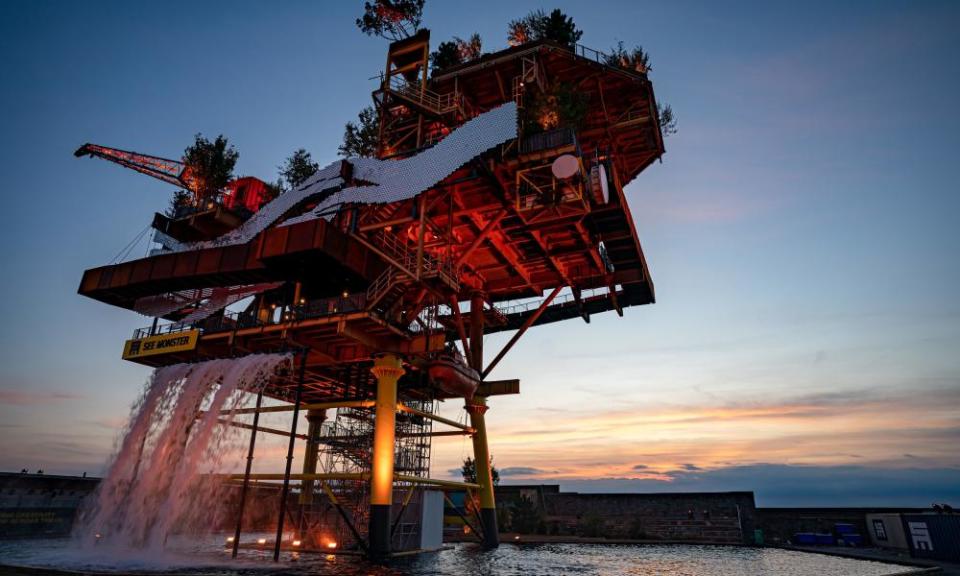‘Festival of Brexit’ visitor numbers fall short of expectations

A national festival celebrating British creativity that cost taxpayers £120m has attracted audiences of 18 million since it opened in the spring, but with only 2.8 million attending live events, according to its organisers.
The headline figure includes the television audience of a special edition of the BBC programme Countryfile broadcast last month, which included a 15-minute segment of content created by Unboxed. Countryfile has an average weekly audience of 6 million.
Related: The Guardian view on Unboxed: so much for the ‘festival of Brexit’ | Editorial
Unboxed, which was commissioned by Theresa May in 2018 and was initially known as the “festival of Brexit”, was “a real investment for the taxpayer”, Phil Batty, its executive director, said.
As well as 2.8 million people visiting free live events, 13.5 million accessed digital and broadcast content and 1.7 million took part in learning, volunteer and community participation activities.
The audience figures far exceed a report in The House magazine in August that claimed 238,000 people had visited Unboxed in its first few months. They also fall far short of an ambitious “stretch target” of 66 million set by the festival’s chief creative officer, Martin Green, who left Unboxed last month to run next year’s Eurovision song contest in Liverpool.
Unboxed provided no breakdown for the 10 projects that formed the overall arts and science festival, saying detailed data would be included in a report by the National Audit Office due to be published next week.
The spending watchdog is investigating whether the eight-month festival was value for money after a parliamentary committee warned of an “irresponsible use” of public funds.
The NAO said it would report on “the costs and benefits associated with Unboxed; its management as a programme including accountabilities and decision- making processes; and planning work undertaken, including forecasting of visitor numbers.”
Calling for the NAO to investigate, Julian Knight, the Conservative MP who chairs the digital, culture, media and sport committee, said: “That such an exorbitant amount of public cash has been spent on a so-called celebration of creativity that has barely failed to register in the public consciousness raises serious red flags about how the project has been managed from conception through to delivery.”
Batty said headline audience data was being released before the NAO report because “there is still misinformation out there”.
He added: “Unboxed has been a real investment for the taxpayer because we’ve had free access to culture in person and online across the eight months during a year when free things for people to access and enjoy has been really important.
“Beneath that, the programme has supported thousands of jobs across not just the cultural sector, but within science, tech, engineering, local communities. So there is a return on that investment, both in terms of amazing cultural participation and the social benefits that that could deliver, and the benefit to the places that we’ve been and the organisations that we’ve invested the money in.”
Green’s aspiration of 66 million people was never a hard target, said Batty. The festival’s goal was “to create something for the whole UK, something that anyone, no matter where they live, could access. So we moved away from traditional forms of festival delivery to find a form of delivery that was much broader, much wider, much more open.”
The live programme finished at the weekend with the closing of See Monster, a public art installation housed on a decommissioned North Sea oil platform relocated to Weston-super-Mare in Somerset, and About Us, an immersive lightshow, at the Tower of London.
The 10 projects, chosen from 300 submitted ideas were available at 107 locations across the UK during the festival. Six thousand jobs and “paid development opportunities” were supported by Unboxed. Green described it as the UK’s “biggest and most ambitious public creative programme to date”.
The free events, installations and digital experiences included an immersive group hallucination triggered by lights, a journey through 13.8bn years of history from the big bang to the present told through a light show, a scale version of the solar system as an 8.5km sculptural trail, and a city centre garden celebrating the diversity of the UK through the lens of plants.
But the project was dogged by the “festival of Brexit” label that arose after May commissioned it.
“It is not a Brexit festival. It never has been a Brexit festival,” said Batty. “And we’ve had to challenge that a lot over the life of this project, which has meant that it has taken up an unfair proportion of the oxygen around the conversation.
“The conversation when people have been engaging with the commissions hasn’t been about Brexit. It’s been about science and about the planet and what we might do with structures like gas rigs in the future if we were to find new purposes for them.”
Stuart Andrew, the minister for sport, tourism and civil society, said the festival had “taken culture to the doorsteps of millions in communities right across the UK” and “inspired people who attended events, got involved online or watched on TV”.

